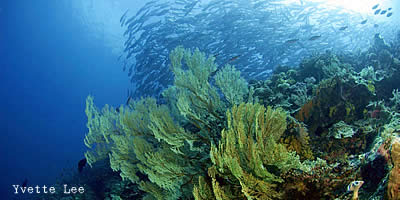Tubbataha Reef
From Wikipedia, the free encyclopedia
All text is available under the terms of the GNU Free Documentation License.
 Tubbataha Reef is an atoll coral reef located in the Sulu Sea, 98 nautical miles (181 km) southeast of Puerto Princesa City, Palawan, the Philippines.
Tubbataha Reef is an atoll coral reef located in the Sulu Sea, 98 nautical miles (181 km) southeast of Puerto Princesa City, Palawan, the Philippines.
It is a marine sanctuary protected as Tubbataha Reef National Marine Park.
Declared a World Heritage Site by the United Nations Educational, Scientific, and Cultural Organization (UNESCO) on December 1993, it is under protective management by the Phillipines Department of National Defense (DND). It is under technical supervision by the Palawan Council for Sustainable Development (PCSD) & the Department of Environment & Natural Resources (DENR). It is administered as part of administered as part of Cagayancillo town on Palawan.
The reef is composed of two atolls, North and South Reefs. Each reef has a single small islet that protrudes from the water. The atolls are separated by a deep channel 8 km (5 miles) wide.
Over one thousand species can be found at on the reef; many are already endangered species. Animal species found include manta rays, lionfish, pawikan or tortoise, clownfish, and sharks.
There are no permanent inhabitants of the islets or reefs. Fisherman visit the area seasonally, establishing shelters on the islets. The park is visited by tourists, particularly divers. Trips to Tubbattaha from mid-March to mid-June are all vessel-based; the park is about twelve hours by boat from Puerto Princesa City. Tubbataha is considered as the best dive site in the Philippines and the diving dedicated ships that opearte during the "Tubbataha Season" are usually booked years in advance especially during the Asian holidays of Easter and "Golden Week"
A marine sanctuary having a reef of enormous size is the Tubbataha National Marine Park located at the Central Sulu Sea. It was established in August 11, 1988 with an area of 33,200 hectares (82,000 acres). In 2006, President Gloria Macapagal Arroyo, through an Executive Order, increased the boundaries of the park by 200%. It is now 96,824 hectares (239,000 acres) in size and is guarded by armed rangers 24 hours/ 7 days a week.
The word "tubbataha" is a combination of two Samal words which means "a long reef exposed at low tide". This reef is made up of two coral atolls divided by an eight-kilometer (5 miles) wide channel. The South Atoll, the smaller of the two is five kilometers in length and three kilometers in width; while the North Atoll, the larger of the two is 16 kilometers (10 miles) long and five kilometers (3 miles) wide. (Knipp 22)
Vivid corals cover more than two-thirds of the area and the waters around the reef are places of refuge for numerous marine lives. The seemingly diverse ecosystem of this sanctuary rivals the Great Barrier Reef – having 300 coral species and 400 fish species. (Knipp 22, 24)
In 1993, the United Nations designated Tubbataha as one of the two World Heritage Sites found in the Philippines. The other site is the Banaue Rice Terraces in Ifugao. (Knipp 24)
Tubbataha has become a popular site for seasoned sports divers because of its coral "walls" where the shallow coral reef abruptly ends giving way to great depths. These "walls" are not only wonderful diving spots but they are also wonderful habitats for many colonies of fish. There are giant jacks, hammerhead sharks, barracudas, manta rays, palm-sized moorish idols, parrot fishes, and moral eels living in the sanctuary. Tubbataha is even home to the hawksbill sea turtles (Eretmochelys imbricata) which are endangered species. (Knipp 24)
Aside from being a marine sanctuary, Tubbataha is also renowned for being a bird sanctuary. A lighthouse islet, at the southern tip of the South Atoll, supports a large number of seabirds which nest there. Around the Tubbataha, there are tens of thousands of masked red-foot boobies, terns, and frigate birds resting during their annual migrations. To minimize any external intrusions, the Philippine Coast Guard maintains a small monitoring station on one of the many permanent sand bars. (Knipp 24)
Tubbataha National Marine Park is truly a national treasure worth protecting. As a senior official of the DENR says,
"As a World Heritage Site, Tubbataha should be protected and preserved so that future generations will also have the opportunity to see one of the greatest wonders of the world." (Knipp 24)













